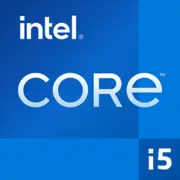Intel Core i5-12500H

Intel Core i5-12500H: A Balance of Power and Mobility in 2025
Introduction
The Intel Core i5-12500H processor, released in early 2022, remains a relevant choice for mid-range laptops even in 2025. With its hybrid Alder Lake architecture and energy-efficient technologies, it has secured its spot in ultrabooks, workstations, and even compact gaming devices. Let's explore who would benefit from this CPU today, what tasks it can handle, and what to pay attention to when purchasing.
Architecture and Process Technology: A Hybrid Approach for Multitasking
Alder Lake: P-cores and E-cores
The Core i5-12500H is built on a hybrid architecture featuring a split between performance (P-cores) and efficiency (E-cores):
- 12 cores (4P + 8E) and 16 threads (Hyper-Threading only works on P-cores).
- P-cores: Base clock speed — 2.5 GHz, maximum in turbo mode — 4.5 GHz.
- E-cores: Base clock speed — 1.8 GHz, maximum — 3.3 GHz.
Intel 7 Process Technology
Despite its name, this is a 10nm technology with improved transistor density. This has led to a 15-20% reduction in power consumption compared to Tiger Lake (11th generation), while performance has increased.
Integrated Graphics Iris Xe
The iGPU with 80 EU (Execution Units) supports:
- 4K/60 Hz via HDMI 2.0 or DisplayPort.
- Intel Deep Link and Quick Sync Video technologies for rendering acceleration.
- Gaming at low settings: for example, _CS:2_ — 50-60 FPS at 1080p, _GTA V_ — 45-55 FPS.
Power Consumption and TDP: Balancing Power and Heat
Nominal TDP is 45 W, but actual consumption depends on the load:
- In idle mode: 5-10 W.
- During streaming or rendering: up to 60-70 W (with Turbo Boost support).
Cooling Features
For stable operation, a system with at least two fans and heat pipes is required. In slim ultrabooks (case thickness <17 mm), P-core frequencies may drop to 3.8-4.0 GHz due to overheating.
Performance: From Office to Gaming
Office Work and Multitasking
- Running 30+ tabs in Chrome + Photoshop + Slack: no delays.
- Rendering a PowerPoint presentation: 20% faster than the i5-11300H.
Multimedia
- Converting 4K video in HandBrake: 8-10 minutes for a 10-minute clip.
- Working in DaVinci Resolve: smooth editing with effects, but for complex color grading, a discrete GPU is recommended.
Gaming
- Iris Xe handles less demanding games: _Fortnite_ (1080p, low settings) — 50-60 FPS, _Valorant_ — 70-80 FPS.
- Paired with a discrete graphics card (for example, NVIDIA RTX 3050), it delivers stable FPS in _Cyberpunk 2077_ (1080p, medium settings).
Turbo Boost: How Long Can It Last?
In laptops with effective cooling (e.g., Lenovo Legion 5 Pro), the processor maintains a frequency of 4.3-4.5 GHz for up to 10-15 minutes under load. In compact models (ASUS ZenBook 14), turbo mode activates in short "bursts" (2-3 minutes).
Use Cases: Who is the i5-12500H Suitable For?
1. Students and Freelancers — for studying, working with documents, and light creativity.
2. Casual Gamers — paired with a discrete GPU or for cloud gaming.
3. Office Workers — multitasking without hiccups.
4. Travelers — models with this CPU often weigh 1.5-1.8 kg and offer 6-8 hours of battery life.
Who Should Avoid It?
- Professionals in 3D modeling or 8K editing — better to choose i7/i9 or Ryzen 7/9.
- Silence enthusiasts — under load, fans can be loud at 40-45 dB.
Battery Life: Energy-Saving Technologies
- Intel Dynamic Tuning — automatically switches between P-cores and E-cores for battery savings.
- Adaptix — optimizes load on the cores in the background.
Examples of Battery Life:
- Web surfing: 6-7 hours (at 150 nits brightness).
- Video playback: 5-6 hours.
- Gaming (with discrete GPU): 1.5-2 hours.
Tip: Choose laptops with a battery of at least 60 Wh — for example, the Dell XPS 15 (2025) with 72 Wh ensures up to 8 hours of operation in "eco mode."
Comparison with Competitors
1. AMD Ryzen 5 7600H (Zen 4, 6 cores/12 threads):
- Better at multi-threaded tasks (e.g., rendering).
- Weaker in single-threaded applications (office programs).
- Laptop prices: $900-$1300.
2. Apple M2 (8 cores):
- 30-40% better battery life.
- Compatibility only with macOS and limited software.
- MacBook Air price: from $1099.
3. Intel Core i7-12650H (10 cores):
- 15-20% more powerful but more expensive ($1100-$1400).
Pros and Cons
Strengths:
- High single-thread performance (Geekbench 6 Single Core — 2003).
- Support for DDR5 and PCIe 4.0.
- Affordable laptop prices (from $800).
Weaknesses:
- Heating in compact chassis.
- Limited upgrade potential (RAM and SSD are often soldered to the motherboard).
Laptop Selection Recommendations
1. Ultrabooks (e.g., Acer Swift X 2025):
- Weight up to 1.4 kg, screen 14-15.6", price $1000-$1200.
- Check the cooling system — at least 2 fans.
2. Gaming Models (MSI Katana GF66):
- Discrete GPU (RTX 3050 or higher), 16 GB RAM, price $1100-$1400.
- Look for a display with a 144 Hz refresh rate.
3. Workstations (HP Envy 16):
- 32 GB RAM, 1 TB SSD, 4K touchscreen.
What to Pay Attention To:
- RAM volume: at least 16 GB DDR5.
- Storage: PCIe 4.0 SSD starting from 512 GB.
- Ports: Thunderbolt 4, HDMI 2.1.
Final Conclusion
In 2025, the Intel Core i5-12500H is an optimal choice for those seeking a balance between price, performance, and mobility. It is suitable for:
- Users who need speed in everyday tasks.
- Gamers willing to compromise on graphics settings.
- Those who value battery life but do not want to overpay for high-end models.
Key Benefits: Support for modern standards (DDR5, Wi-Fi 6E), hybrid architecture for intelligent load distribution, and an affordable price. If your budget is limited to $800-$1200, this processor is one of the best options on the market.
Basic
CPU Specifications
Memory Specifications
GPU Specifications
Miscellaneous
Benchmarks
Compared to Other CPU
Related CPU Comparisons
Share in social media
Or Link To Us
<a href="https://cputronic.com/cpu/intel-core-i5-12500h" target="_blank">Intel Core i5-12500H</a>

